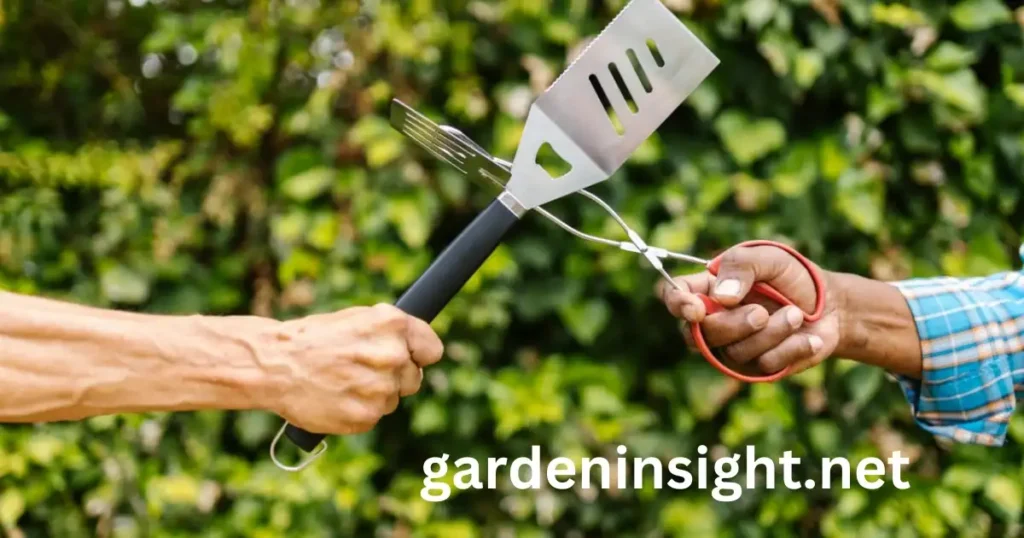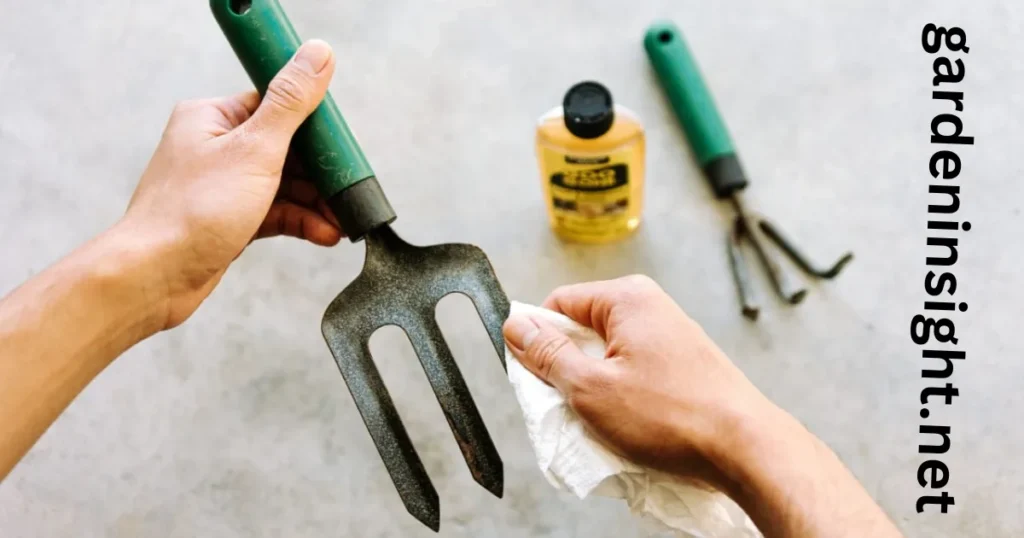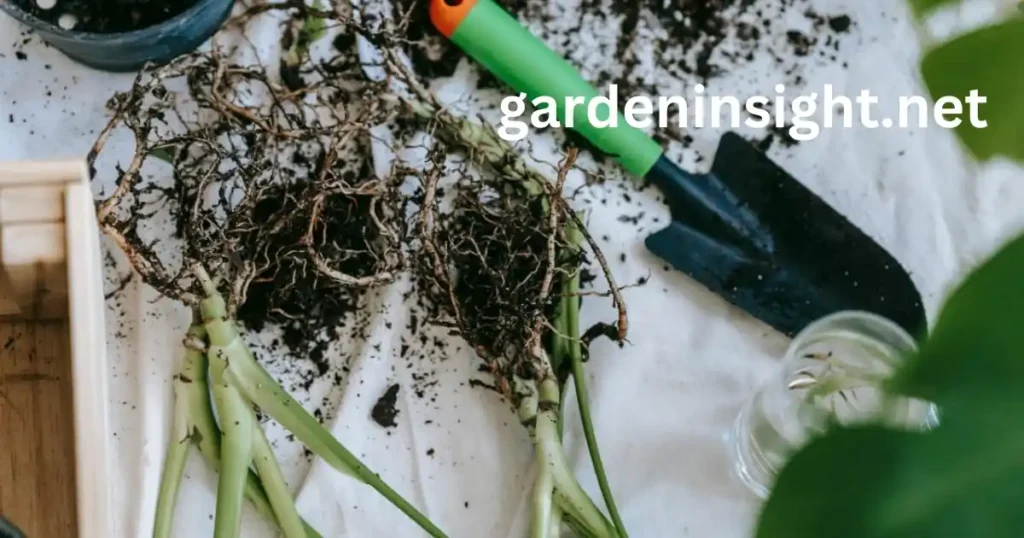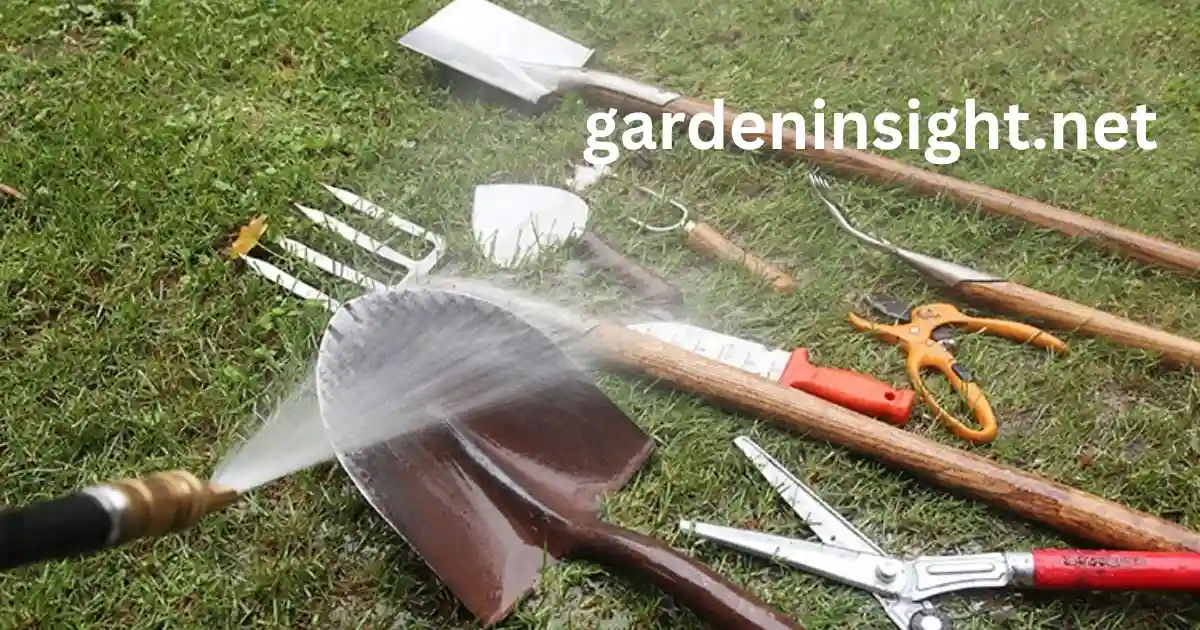To clean gardening tools is essential for maintaining their functionality and longevity. Clean gardening tools tools are less likely to spread disease, rust, or become damaged.
This comprehensive guide will provide you with all the information you need to keep clean gardening tools in top condition.
Why is It Important To Clean Gardening Tools

To clean gardening tools isn’t just about aesthetics; it has a direct impact on the health of your plants and the longevity of your tools. Here’s why:
- Disease Prevention: Soil and plant debris can harbor bacteria, fungi, and viruses that cause plant diseases. Cleaning your tools helps prevent the spread of these pathogens from one plant to another.
- Rust Prevention: Moisture left on metal tools can lead to rust, which weakens the metal and makes tools less effective. Cleaning and drying your tools properly prevents rust formation.
- Improved Performance: Clean tools work more efficiently. Sharp blades make cleaner cuts, reducing stress on plants, and soil-free tools penetrate the ground more easily.
- Extended Tool Lifespan: Regular cleaning and maintenance can significantly extend the life of your gardening tools, saving you money in the long run.
Best Cleaning Solutions To Clean Gardening Tools
Choosing the right cleaning solution is crucial to keep clean gardening tools without damaging your tools. Here are some recommended options:
- Soapy Water: A simple solution of warm water and dish soap is often enough to remove most dirt and grime to clean gardening tools.
- Vinegar: White vinegar is a natural disinfectant and can help remove rust. Soak your tools in a solution of equal parts water and vinegar for about 30 minutes to clean gardening tools.
- Baking Soda: Baking soda is a mild abrasive that can help remove stubborn dirt and sap. Make a paste with water and apply it to the tool, then scrub with a brush to clean gardening tools effectively.
- Commercial Disinfectants: For heavy-duty cleaning or when dealing with diseased plants, consider using a commercial disinfectant specifically designed to clean gardening tools. Always follow the manufacturer’s instructions.
| Cleaning Solution | Best For | How to Use |
|---|---|---|
| Soapy Water | General cleaning | Mix warm water with dish soap and scrub tools with a brush. |
| Vinegar | Rust removal, disinfection | Soak tools in a 1:1 solution of water and vinegar for 30 minutes. |
| Baking Soda | Stubborn dirt, sap | Make a paste with water and scrub onto tools. |
| Commercial Disinfectants | Heavy-duty cleaning, disease control | Follow manufacturer’s instructions. |
Steps to Disinfect And Clean Gardening Tools
Disinfecting your tools is especially important after working with diseased plants or when you want to ensure they are completely free of harmful pathogens. Here’s a step-by-step guide:
- Clean the Tools: Remove any visible dirt and debris using a brush, water, and soap.
- Prepare the Disinfecting Solution: Mix one part bleach with nine parts water in a bucket.
- Soak the Tools: Submerge the tools in the bleach solution for at least 30 minutes.
- Rinse and Dry: Rinse the tools thoroughly with clean water and dry them completely with a cloth.
Important Note: Always wear gloves when handling bleach, and work in a well-ventilated area.
Preventing Rust To Get Clean Gardening Tools

Rust can significantly shorten the lifespan of your tools. Here are some effective ways to prevent rust:
- Keep Tools Dry: After cleaning, dry your tools thoroughly, paying special attention to joints and crevices.
- Apply Oil: Apply a light coat of oil, such as linseed oil or WD-40, to metal surfaces to create a protective barrier against moisture.
- Store Properly: Store tools in a dry place, preferably hanging them up to prevent moisture buildup.
Ways to get rid of rust: A Quick Look
| Method | Description | Benefits |
|---|---|---|
| Thorough Drying | Dry tools completely after each use, paying attention to joints and crevices. | Prevents moisture from causing rust. |
| Oiling | Apply a light coat of oil (linseed oil, WD-40) to metal surfaces. | Creates a protective barrier against moisture. |
| Proper Storage | Store tools in a dry place, hang them up to prevent moisture buildup. | Reduces exposure to moisture and humidity. |
| Keep Tools Sharp | Sharpen tools regularly. Sharp tools are less likely to rust. | Improves tool performance and reduces rust formation. |
| Avoid Harsh Chemicals | Avoid using harsh chemicals that can damage tool surfaces and promote rust. | Protects the tool’s finish and prevents corrosion. |
| Wooden Handle Care | Regularly oil wooden handles to prevent cracking, which can expose metal to moisture. | Maintains the integrity of the handle and protects the metal. |
| Inspect for Damage | Regularly inspect tools for any damage that could expose metal to moisture. | Early detection of damage helps prevent rust formation. |
Safe Storage for Clean Gardening Tools
Proper storage is crucial for keeping your tools clean, organized, and in good condition. Here are some tips:
- Designated Storage Area: Create a designated space for your tools, such as a shed, garage, or tool rack.
- Hang Tools: Hang tools whenever possible to prevent moisture buildup and damage to blades.
- Organize by Type: Group similar tools together for easy access and to prevent them from getting tangled or damaged.
- Protect Sharp Edges: Use blade guards or sheaths to protect sharp edges and prevent accidents.
Eco-Friendly Methods To Clean Gardening Tools

If you’re looking for environmentally friendly ways to clean your gardening tools, consider these options:
- Use Biodegradable Soap: Choose a biodegradable soap for cleaning your tools.
- Vinegar and Baking Soda: These natural cleaning agents are effective and safe for the environment.
- Avoid Harsh Chemicals: Steer clear of harsh chemicals that can harm plants and pollute the soil.
Eco-Friendly Methods to Clean Gardening Tool: A Quick Look
| Method | Description | Benefits | Tools/Materials |
|---|---|---|---|
| Soapy Water | Mix warm water with biodegradable dish soap. Scrub tools with a brush or sponge. | Simple, effective for general cleaning, safe for plants and soil. | Bucket, warm water, biodegradable dish soap, brush or sponge |
| Vinegar Soak | Soak tools in a 1:1 solution of white vinegar and water for 30 minutes. Scrub with a brush. | Removes rust, disinfects, safe for the environment. | Bucket, white vinegar, water, brush |
| Baking Soda Paste | Make a paste of baking soda and water. Apply to stubborn dirt or sap, scrub, and rinse. | Mild abrasive, removes tough grime, environmentally friendly. | Baking soda, water, cloth or brush |
| Sharp Sand Scrub | Fill a bucket with sharp sand. Plunge tools into the sand repeatedly to remove dirt and sap. | Effective for cleaning and polishing metal tools, reusable sand. | Bucket, sharp sand |
| Plant-Based Oil | Apply linseed oil or another plant-based oil to metal surfaces after cleaning. | Protects against rust, conditions wooden handles. | Linseed oil or other plant-based oil, cloth |
How to Sharpen Gardening Tools After Cleaning
Sharp tools are essential for healthy plants and efficient gardening. Here’s how to sharpen your tools:
- Use a File or Sharpening Stone: Depending on the tool, use a file or sharpening stone to sharpen the blade.
- Maintain the Original Angle: Try to maintain the original angle of the blade when sharpening.
- Use a Honing Oil: For sharpening stones, use a honing oil to lubricate the stone and prevent damage to the blade.
Removing Sap and Dirt for Clean Gardening Tools

Sap and dirt can be particularly stubborn to remove from gardening tools. Here are some tips:
- Soak in Soapy Water: Soak the tools in warm, soapy water for a few minutes to loosen the sap and dirt.
- Use a Scrub Brush: Use a stiff scrub brush to remove the remaining sap and dirt.
- Use a Solvent: For stubborn sap, try using a solvent like rubbing alcohol or mineral spirits. Apply it to a cloth and rub the affected area.
How Often to Clean Gardening Tools
Ideally, you should clean your gardening tools after each use. However, at the very least, you should clean them:
- Before Storage: Always dry and clean gardening tools before storing them for any length of time.
- After Working with Diseased Plants: Disinfect your tools immediately after working with diseased plants to prevent the spread of disease.
- At the End of the Growing Season: Give your tools a thorough cleaning and inspection at the end of the growing season.
Conclusion
Maintaining the health of your plants and ensuring your gardening tools last for years to come depends on keeping those tools clean. This guide has shown you the most effective ways to clean gardening tools, and by using these methods, you can be sure your tools are always clean, sharp, and ready for the next gardening task.
Remember to clean gardening tools regularly, choosing the right cleaning solutions for the job. When you clean gardening tools, you should also disinfect them to prevent the spread of disease. Don’t forget that to clean gardening tools properly includes preventing rust by drying them thoroughly and applying oil if necessary.
Always store your clean gardening tools correctly to protect them from damage and the elements. With a bit of care and attention when you clean gardening tools, they will be reliable partners in your journey to clean gardening tools.
To summarize, remember these key points when you clean gardening tools:
- Clean gardening tools after each use. This helps prevent the buildup of dirt and grime, making future cleaning easier.
- Clean gardening tools with the appropriate cleaning solution. Soapy water is often sufficient, but tougher jobs may require vinegar, baking soda, or commercial disinfectants.
- Clean gardening tools and disinfect them regularly. This helps prevent the spread of plant diseases.
- Clean gardening tools and dry them thoroughly to prevent rust. You can also apply a light coat of oil for added protection.
- Clean gardening tools and store them properly in a dry place. This will help keep them clean and in good condition.
By following these simple tips, you can ensure that your clean gardening tools are always ready for use and will last for many years.
FAQs: How to Clean Gardening Tools
How do you clean rusty garden tools?
Soak the rusty tools in a solution of equal parts white vinegar and water for about 30 minutes. Then, scrub the rust off with a wire brush or steel wool. For stubborn rust, you can use a commercial rust remover.
What is the best way to clean gardening tools with wooden handles?
Avoid soaking wooden handles in water, as this can cause them to swell and crack. Instead, wipe them down with a damp cloth and soapy water, then dry them thoroughly. You can also apply a coat of linseed oil to protect the wood.
Can I use bleach to clean gardening tools?
Yes, you can use a diluted bleach solution (one part bleach to nine parts water) to disinfect your gardening tools. However, be sure to rinse the tools thoroughly after using bleach, as it can corrode metal.
How do I sharpen pruning shears?
Use a sharpening stone or file to sharpen the blades of your pruning shears. Maintain the original angle of the blade and use a honing oil if you’re using a sharpening stone.
What is the best way to store garden tools?
Store your garden tools in a dry place, preferably hanging them up to prevent moisture buildup. You can also use a tool rack or organizer to keep them organized and protect their sharp edges.
